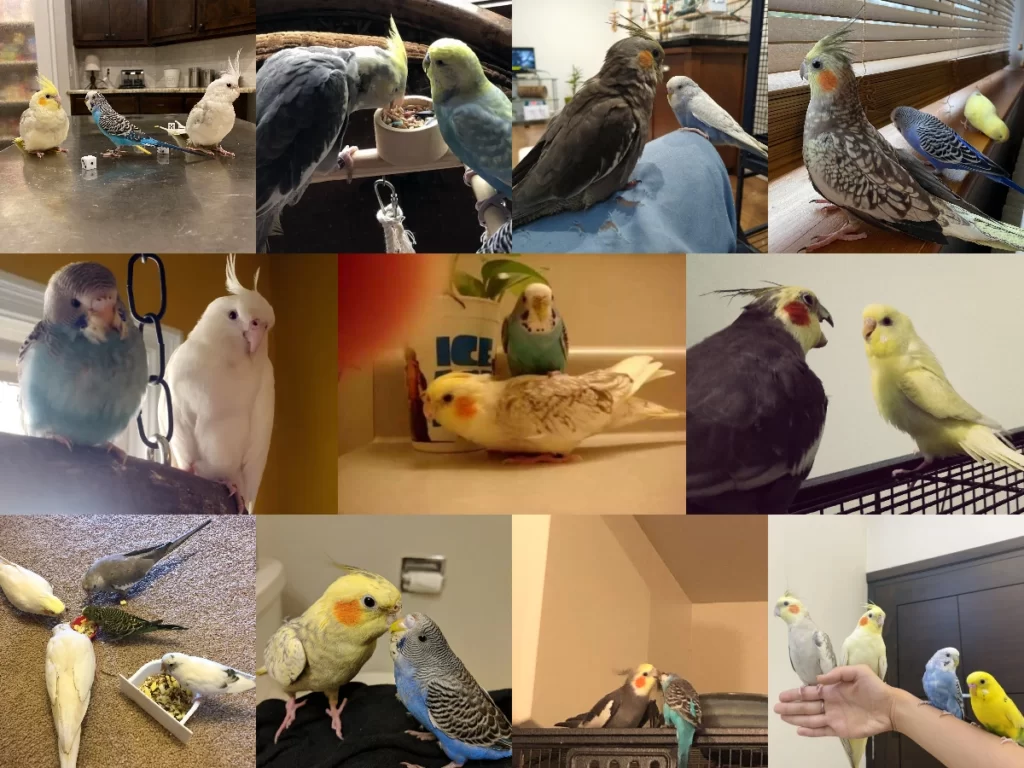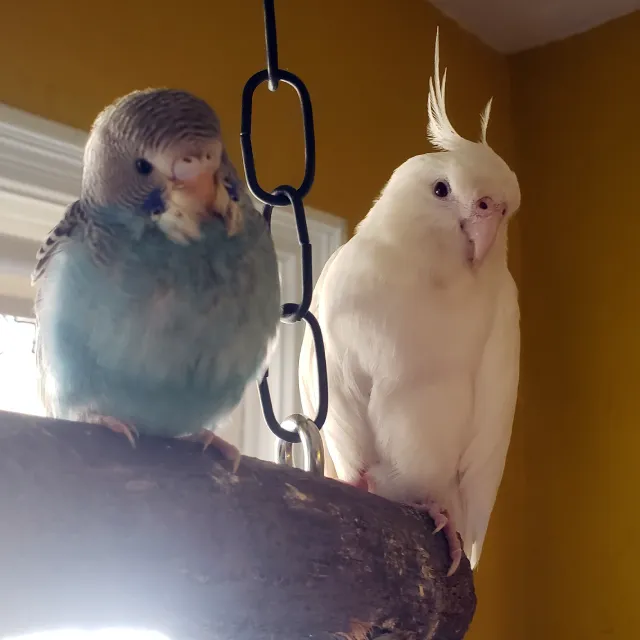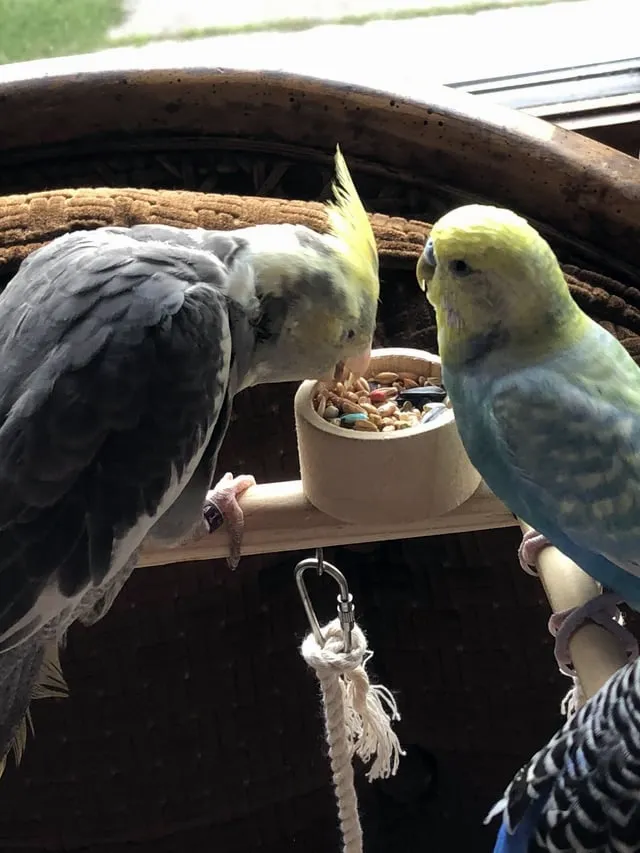Budgies and Cockatiels can cohabit, but it’s essential for pet owners to understand the nuances.
While both birds have unique talking abilities, successful cohabitation depends on factors like cage size, introduction strategies, and recognizing healthy interactions.
Mutual grooming, shared songs, and stress-free behaviors indicate a positive coexistence. Addressing individual needs and mitigating risks, such as territorial behaviors, ensures they live harmoniously.
This guide delves into the fascinating world of budgies and cockatiels, exploring their potential to cohabit peacefully.
Drawing from my personal experiences with budgies and comprehensive research, I aim to answer the burning question: Can these birds live harmoniously together?
Perfect for bird lovers, this content offers valuable insights into bird dynamics, their unique characteristics, and guidelines for a happy shared environment.

Understanding Budgies and Cockatiels
Budgies and cockatiels are two popular bird species that pet owners adore.
Let’s dive deep into understanding their backgrounds, distinctive behaviors, and vocal abilities.
Knowing your pet’s nature and origin can significantly influence how you care for them and ensure their well-being.
Budgie Overview
Budgies have always captured the hearts of many. Let’s explore where they come from and what makes them unique.
- Origins, characteristics, and behaviors: Native to Australia, budgies are small birds with vibrant colors that can range from green, blue, yellow to even white. Weighing around 1 ounce (28 grams), these petite creatures have a wingspan of 10-14 inches (25-35 cm). They are known for their playful nature, chirping melodies, and lively personalities.
- Special mention of English Budgies and their traits: English Budgies are a bit different from their regular counterparts. They are larger, with a distinctively broader head and fuller cheeks. Originating from selective breeding in England, they showcase vibrant color mutations. These birds are more docile, making them a favorite for those who prefer calmer pets.
- Budgie talking abilities and popular phrases: Budgies can mimic sounds remarkably well, given their size. They can reproduce tunes, mimic household noises, and even learn words. Some budgies can learn phrases like “Hello!”, “How are you?”, or “Pretty bird”. With patience, one might be surprised at how chatty their little feathered friend can get.
Cockatiel Overview
Switching gears to cockatiels, another delightful bird species. Let’s uncover what makes them stand out.
- Origins, characteristics, and behaviors: Hailing from Australia, just like budgies, cockatiels are larger with a distinct crest on their heads. They weigh about 3 ounces (85 grams) and can flaunt a wingspan of 12-14 inches (30-35 cm). Their colors vary from grey to yellow and even white. Cockatiels are known for their affectionate behavior, often seen nuzzling their owners.
- Cockatiel talking skills and common sounds: Cockatiels might not be as talkative as budgies, but they have their charm. They are exceptional at whistling and can even mimic popular tunes. While their vocabulary might be limited compared to budgies, phrases like “Good bird” or “Whatcha doing?” are not uncommon. Furthermore, they are experts at imitating common household noises like the ringing of a phone or a microwave’s beep.
Cohabitation: The Reality and Myths
Cohabitation, or the act of different bird species living together, has its share of truths and tales.
There’s a lot that goes into ensuring harmony between budgies and cockatiels when they share a living space.
Let’s clear up some myths and bring light to the real aspects of cohabitation.
Dispelling common misconceptions: Many think that all birds of the same size will get along without any hitches.
However, that’s not always true. Just because both budgies and cockatiels come from Australia doesn’t mean they’ll be best pals.
Every bird has a unique temperament. Moreover, there’s a belief that a larger cage means guaranteed peace.
In reality, cage size is just one factor among many.
Factors that influence successful cohabitation: The key to a peaceful coexistence lies in understanding a few vital factors:
- Personalities of the Birds: Just like humans, some birds are more sociable, while others might be introverts.
- Cage Size and Design: A 24×24 inch (60×60 cm) cage might be suitable for a single bird, but when two are involved, considering larger dimensions is wise.
- Introduction Techniques: Gradually introducing the birds to each other can reduce potential conflicts.
- Monitoring Interactions: Regularly observing their behavior ensures that no bird is stressed or bullied.

Benefits of Cohabitation
If done right, housing budgies and cockatiels together can be a rewarding experience.
But what’s in it for the birds?
- Social companionship benefits: Birds, by nature, are social creatures. They thrive in company. Having a feathery friend can lead to shared games, mutual grooming, and even synchronized singing sessions. This companionship can reduce feelings of loneliness, especially when the owners aren’t around.
- Efficient space utilization and mutual environment perks: Instead of maintaining two separate cages, cohabitation allows pet owners to use one larger, spacious habitat. Not only does this save space, but it also creates an enriched environment. Birds can learn from each other, pick up new sounds, and even share toys. A shared space means they’ll have more toys, perches, and activities, ensuring a more engaging environment for them.

Cage Sharing: Tips and Guidelines 📺
When it comes to letting different birds live together, the cage plays a central role.
The right environment helps birds bond, while the wrong one might create tension.
Here are some guidelines on making cage sharing smooth for both budgies and cockatiels.
- Choosing the optimal cage for both species: The best cage is spacious with room to fly, play, and rest separately. For a budgie and cockatiel living together, a cage that’s at least 40×40 inches (about 102×102 cm) is a good start. The cage should have horizontal bars for easy climbing, multiple perches, and separate feeding stations.
- Introducing each bird to shared living space: Start by letting each bird explore the cage on its own for a day. This helps them get comfortable. After that, introduce them to the cage at the same time, but supervise closely. If there are no signs of aggression, they can start living together.
- Signs to ensure they coexist peacefully: Regularly check for signs of friendship, like mutual grooming or playing together. On the flip side, if one bird is always hiding or seems scared, it might not be working out.
Challenges of Cohabitation
Like in any shared living situation, challenges can arise. But understanding these challenges can help in solving them early.
- Addressing territorial behaviors: Sometimes, birds can be a little selfish about their space. If a bird starts being aggressive around a particular toy or perch, it’s showing territorial behavior. A solution might be to have multiple toys or perches of the same type, so each bird has its own.
- Recognizing and mitigating bullying risks: Bullying isn’t just a schoolyard problem; birds can do it too. If one bird is always chasing the other or taking its food, that’s a sign. Separating them for a short period or giving them individual playtimes can help reduce this behavior.
- Ensuring individual dietary and health needs: Just like people, birds have their own favorite foods and health needs. Budgies and cockatiels have slightly different diets. So, it’s important to make sure each bird gets its special food. Also, if one bird looks sick, it’s best to check with a vet and keep them separate until they’re better.
Compatibility & Bird Dynamics
In the bird world, friendships and dynamics between species can be as intricate and fascinating as human relationships.
Let’s understand how budgies and cockatiels get along and the ways to make their bond stronger.
Budgies and cockatiels, both native to Australia, often have overlapping habitats. This means they’ve had centuries to understand each other.
However, in a home setting, it’s not always a guarantee that they’ll be best buddies.
Just like people, birds have their own personalities. Some might click instantly, while others might need time.
Indicators of compatibility and potential red flags: Positive signs include chirping to each other, sitting close, and sharing food.
On the other hand, constant squawking, chasing, or plucking each other’s feathers are definite no-nos.
If you see these, it might mean they need a break from each other.
Factors affecting mutual acceptance: Age can play a role. Younger birds are often more adaptable and open to making new friends.
The gender of the birds can also influence their dynamic. Two males might compete more, while a male and a female might be more accepting.
Role of cage environment in influencing compatibility: A cage can be like a playground or a battlefield, depending on its setup.
If there’s only one food bowl or perch, birds might fight over it.
But, multiple toys, perches, and bowls can mean they have enough to share.
Space matters too! A roomy cage, let’s say around 50×50 inches (approximately 127×127 cm), gives both birds enough personal space.
Introduction strategies for new bird friendships: When introducing a budgie and a cockatiel for the first time, start slow.
Let them be in separate cages but in the same room. This way, they can see and hear each other.
After a week, allow supervised playtimes outside the cage. Watch their behavior.
If they seem curious and friendly, you can gradually let them share a cage.
But remember, patience is key.
Recognizing Healthy Bird Interactions 📺
Birds, like humans, have their own unique ways to show love, trust, and comfort.
Recognizing these signs helps ensure our feathery friends are getting along and feeling good.
Importance of mutual grooming: When birds groom each other, it’s a sign they trust one another.
It’s like giving a friend a hairbrush and letting them style your hair.
If your budgie and cockatiel preen each other’s feathers, it’s a big thumbs up for their friendship.
Signs of bonding like shared songs or games: Music and play are universal languages.
If you notice your birds singing together or copying each other’s tunes, it’s a joyful duet.
Similarly, if they play games, like passing a toy back and forth, they’re having a fun time together.
Indicators of a stress-free coexistence: A calm bird is a happy bird.
Signs they’re stress-free include relaxed postures, smooth feathers, and gentle chirping. If they eat and sleep without issues, it means they’re comfortable with their roommate.
Talking Abilities Showdown: Budgie Vs. Cockatiel
The world of bird chatter is vast and vibrant. Let’s dive into who, between budgies and cockatiels, holds the crown for being the top talker.
Setting the stage: Which bird is the superior talker?
The answer might surprise many. While both birds are vocal, budgies generally have a slight edge when it comes to mimicking human speech.
But both species bring their unique charm to the table.
Comparative list of phrases and sounds for each species
| Budgies | Cockatiels |
|---|---|
| “Hello” and “How are you?” | Whistles and tunes |
| Mimics phone rings and doorbells | “Pretty bird” chirp |
| Laughter sounds | Sounds resembling household items like a microwave |
Training methods to enhance their talking skills
Training a bird to talk is like teaching a toddler new words.
The key is repetition. Speak to your bird daily, keep the phrases short, and always reward them with treats when they get it right.
Play recordings or music for them to mimic. Remember, patience and positivity are your best tools here.
FAQs
Can Budgies and Cockatiels Interbreed?
This is a common question for many bird enthusiasts. The simple answer is no.
Budgies and cockatiels are two distinct species with different genetic makeups. It’s like trying to mix a cat and a dog.
While they can be best friends, they can’t produce offspring together.
How to Handle Bird Disagreements and Signs of Distress
Like all roommates, birds might have their disagreements. Signs of distress include loud and frantic chirping, aggressive behaviors like biting or chasing, and feathers being plucked.
If these occur, it’s essential to intervene. Consider separating them for a while and reintroducing them gradually.
Sometimes, just a simple cage rearrangement helps in easing tensions.
Absolutely! Both species love to play and explore. However, ensure that the toys and accessories are safe and appropriate for their size.
Always monitor their initial reactions to a new toy to make sure both are comfortable with it.
Should the Introduction of Budgies and Cockatiels Occur During a Specific Time of Day?
Time can play a role in setting the right mood. Mornings, after they’ve had a good night’s sleep, can be an optimal time.
Birds are often more energetic and inquisitive in the early hours. However, any time of day that’s calm and quiet works.
The key is to ensure a stress-free environment during their first meeting.
What Precautions Should Be Taken When Traveling With Both Birds?
Traveling with pets can be a joy, but when it comes to flying friends like budgies and cockatiels, we need some extra care.
Secure and comfortable cages are vital. Ensure each bird has its own space, but place their cages close enough for them to see each other.
This helps reduce stress. Don’t forget to pack their favorite toys and some familiar items to give them a sense of home while on the move.
How Can Owners Ensure a Balanced Diet for Both Species When They Live Together?
Diet is crucial for our birds’ health. Budgies and cockatiels have similar dietary needs, but there are differences.
For a balanced diet, serve them a mix of pellets, fresh fruits, and vegetables.
Ensure the food size is appropriate for each bird. A large piece of fruit might be perfect for a cockatiel but challenging for a budgie.
Monitor their eating habits and ensure one isn’t eating all the food.
How Do Mating Seasons Affect Cohabitation Dynamics?
When birds are in their mating seasons, their behaviors change. They might become more territorial or exhibit mating rituals.
For cohabitation, this means you should watch for signs of aggression or over-attachment.
Providing separate nesting areas can help, especially if they start collecting nesting materials.
What Health Checks Should Be Conducted Before Cohabiting These Birds?
Health comes first, especially when introducing new housemates. Both birds should undergo health checks by a veterinarian.
This ensures neither bird has illnesses that could spread. Look for clear eyes, clean feathers, and listen for steady breathing.
Regular health checks keep our feathery friends happy and chirpy!
While both birds love cozy spaces, it’s best to give them individual nesting areas.
They have different nesting behaviors and might disturb each other if forced to share.
A cockatiel might need more space, while a budgie prefers a tighter spot.
By giving them their unique nests, they’ll have their private retreats.
How Do You Manage Different Sleep Cycles Between the Two Birds?
Rest is important for birds. Budgies and cockatiels have similar sleep needs, but there might be slight differences in their sleep cycles.
To manage this, ensure their cage placement allows for sections of shade and light.
If one bird wants to nap while the other plays, they can easily find their comfy spot.
And always ensure the room is quiet during their primary sleep hours.
No one likes to be jolted awake!
How Often Should the Cage Be Cleaned When Housing Both Birds Together?
Cleanliness is key for a happy bird environment. When housing both budgies and cockatiels, the cage should be cleaned at least once a week.
Wipe down surfaces, change the liner, and ensure their water and food dishes are clean.
Remember, more birds mean more mess, so keep an eye out!
What Are Common Misconceptions About Budgie and Cockatiel Cohabitation?
Many people believe that all birds can live together with ease. However, that’s not always the case.
A common misconception is that budgies and cockatiels require the same environment and care.
While they have similarities, each species has unique needs. Another myth is that they’ll always get along; like humans, birds have personalities and may or may not gel well.
How Can Owners Facilitate Social Interaction Between Budgies and Cockatiels Without Stress?
The key to a successful bird friendship is patience. Introduce budgies and cockatiels slowly and in neutral spaces.
Let them observe each other without physical interaction first. Over time, allow supervised playtimes outside the cage.
Toys can also be a great ice-breaker. Make sure to watch for signs of stress and separate them if necessary.
What Should Be Done if One Bird Becomes Ill While Cohabiting?
Bird health is fragile. If one bird shows signs of illness, isolate it immediately.
This helps in preventing potential spread. Consult a vet, ensure the sick bird gets proper care, and monitor the other bird closely for similar symptoms.
Can Young Budgies and Cockatiels Be Introduced to Each Other More Easily?
Age can play a role in bird introductions. Younger birds tend to be more adaptable and less set in their ways.
While introducing young budgies and cockatiels can be smoother, they still require careful, gradual introductions.
The plus side is, if they grow up together, they often form stronger bonds.
What Are the Long-term Impacts of Cohabitation on the Lifespan of Both Birds?
Living together can have varied effects on birds. Positive cohabitation can lead to enriched environments, which may positively impact health and lifespan.
On the other hand, constant stress or conflict can reduce a bird’s lifespan.
It’s all about the quality of their interaction. With proper care and attention to their needs, cohabitation can be a delightful experience for both budgies and cockatiels.


